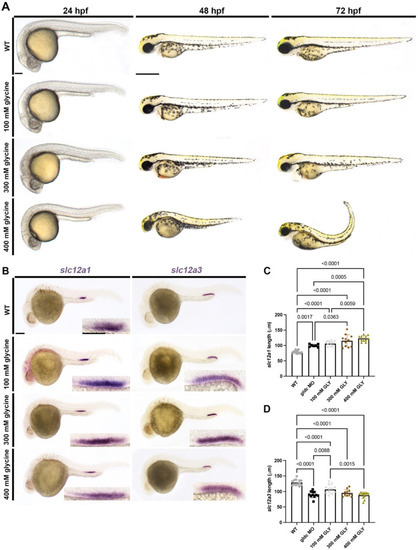Glycine-treated embryos altered live morphology and segment patterning in a dose-dependent manner, comparable to gldc morphants. (A) Live images of WT and glycine-treated animals at 24 hpf, 48 hpf, and 72 hpf. Animals were treated with three different concentrations of glycine: 100 mM, 300 mM, and 400 mM. Imaging revealed gray pallor in the brain at 24 hpf in 300 mM and 400 mM animals. Pericardial edema and hydrocephalus became evident in 300 mM zebrafish at 48 hpf and became severe at 72 hpf with aberrant jaw morphology. Mild fluid retention was seen in 100 mM animals at 72 hpf. Zebrafish treated with 400 mM glycine exhibited severe body curvature and overall altered morphology at 72 hpf. Scale bars = 100 μM (24 hpf) and 400 μM (48 hpf and 72 hpf). (B) WISH of WT and glycine-treated zebrafish at 24 hpf analyzing slc12a1 and slc12a3. The slc12a1 domain elongates in glycine-treated animals in a dose-dependent manner. The slc12a3 domain becomes reduced in the treatment group in a dose-dependent manner as well. Scale bars = 100 μM (main image) and 50 μM (inset). (C,D) Absolute length quantifications of slc12a1 and slc12a3 comparing WT and treatment groups. Data are mean ± s.d. Absolute lengths were compared with ANOVA.

